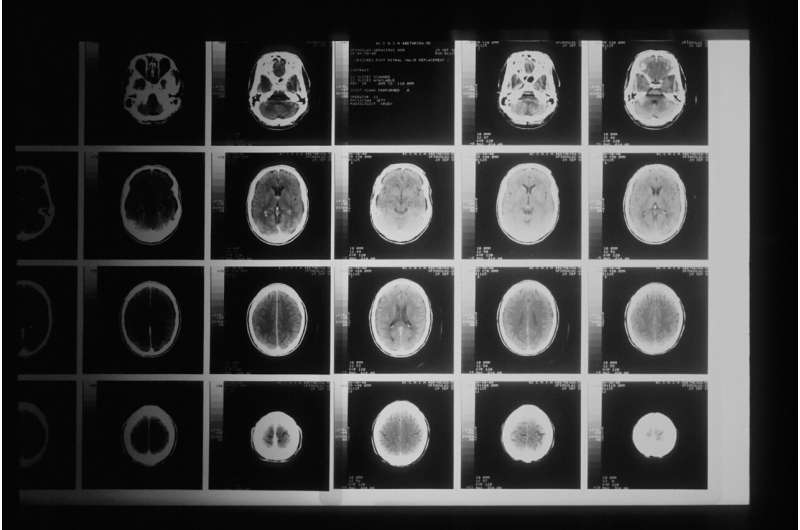Genetic test can diagnose brain tumors in as little as two hours


Scientists and medics have developed an ultra-rapid method of genetically diagnosing brain tumors that will cut the time it takes to classify them from six to eight weeks, to as little as two hours—which could improve care for thousands of patients each year in the UK.
The method, which is detailed in a study published in Neuro-Oncology, has been developed by scientists at the University of Nottingham along with clinicians at Nottingham University Hospitals NHS Trust (NUH).
In the published work, the team at NUH utilized the new approach during 50 brain tumor surgeries to deliver rapid, intraoperative diagnoses.
This approach has achieved a 100% success rate, providing diagnostic results in under two hours from surgery and detailed tumor classifications within minutes of sequencing. Moreover, the platform’s ability to continue sequencing enables a fully integrated diagnosis within 24 hours.
Every day in the UK, 34 people are diagnosed with some form of brain tumor, equating to more than 12,000 cases a year. The average survival rate can be less than a year for the most aggressive brain cancers.
Brain tumors require complex genetic tests to diagnose, which clinicians currently have to send away to centralized analysis facilities. It can take six to eight weeks or more to get full results to be able to inform patients what type of tumor they have and their prognosis. This long wait is extremely traumatic for patients, and also delays the start of radiotherapy and chemotherapy, which may reduce the chances of treatment working.
The team of experts in Nottingham have developed an ultra-rapid way of genetically diagnosing brain tumors that will eliminate this delay. The method is so quick that they can even get results within a couple of hours and potentially make this information available to the surgeon during the operation to inform surgical decision-making.
Dr. Stuart Smith is a Neurosurgeon from the School of Medicine at the University and within NUH.
He said, “Traditionally, the process of diagnosing brain tumors has been slow and expensive. Now, with this new technology, we can do more for patients because we can get answers so much more quickly, which will have a much bigger influence on clinical decision-making, in as little as two hours. Patients find waiting many weeks for results extremely difficult and this adds to the anxiety and worry at what is already a very difficult time.”
“This type of operation can be quite long, so potentially, a surgeon could be informed during surgery of the accurate diagnosis, which would then impact on the surgical strategy.”
The current treatment pathway starts with an MRI scan to ascertain the presence of a tumor. Patients will speak to clinicians to discuss the possibilities of what type of tumor they may have. For many tumor types, people would then undergo some form of surgery to obtain a sample of the tumor, which is currently sent away to centralized labs for testing to look for abnormalities in the DNA which will determine what type of tumor it is.
Traditionally, experts would then look at the specimens and the neuropathology view would be to try and identify the cells visually. But in the last few years, the process has changed and tumors are categorized on DNA and genetic abnormalities—which traditionally is a slow process due to technological limitations.
Professor Matt Loose, a biologist from the School of Life Sciences at the University of Nottingham, developed a method to sequence specific parts of human DNA at higher depth using Oxford Nanopore Technologies portable sequencing devices. This method allows relevant parts of the human genome to be examined much more quickly and multiple regions of DNA sequenced at the same time—speeding up the whole process.
The team have now used this method to genetically test brain tumor samples.
ROBIN, a software tool based on the P2 PromethION nanopore sequencers, sequences the DNA by detecting the change in current flow as single molecules of DNA pass through a nanopore—or tiny hole—in a membrane.
Professor Loose said, “When we first were able to sequence an entire human genome in 2018, it took around five labs and six months to do, which obviously isn’t ideal when time is of the essence for a patient.
“This new method now allows us to choose the bits of DNA that we need to look at in order to answer specific questions, such as what type of tumor and how can it be treated. Combined with our later research, where we were able to look at relevant parts of the human genome more quickly—then we now have a process where we can use ROBIN to create comprehensive classifications of tumors more quickly.
“Once we have a sample from a patient, we can now quickly extract the DNA and look at the different properties to give us the information we need. Methylation is the one we are most interested in early on in this instance because that defines the tumor type.”
Once a sample has been removed during surgery, it is sent to the pathology lab, where they would extract DNA before it is sent to the team to sequence.
Dr. Simon Paine, a Consultant Neuropathologist at NUH said, “This new method of diagnosing brain tumors is going to be a game-changer. It really is revolutionary. It not only increases the speed at which the results will be available, but the degree of accuracy of the diagnosis as well is incredible.”
The team are now looking to get the new testing rolled out at NHS Trusts across the UK.
“Not only is the test more accurate and quicker, but it is also cheaper than current methods,” said Professor Loose.
“Our calculations stand at around £450 per person, potentially less when scaled-up. There are a few reasons for this. Our method can eliminate the need for four to five separate tests, reducing costs as a consequence as we are getting more information from the single test we do. Most importantly, it delivers results to the patients when they need them.”
Dr. Simon Newman, Chief Scientific Officer at The Brain Tumor Charity, said, “The delivery of an accurate diagnosis within hours of surgery will be transformative for all patients ensuring rapid access to the optimal standard of care and—crucially—removing the uncertainty patients face when having to wait weeks for their diagnosis and prognosis.
“The potential to combine so many separate tests into one and deliver at a localized level is a game-changer for driving equity of access to rapid and accurate molecular diagnosis. The BRAIN MATRIX Trial … is now exploring how this technology can match patients to personalized clinical trials across the UK.”
More information:
Matthew Loose et al, ROBIN: A unified nanopore-based assay integrating intraoperative methylome classification and next-day comprehensive profiling for ultra-rapid tumour diagnosis, Neuro-Oncology (2025). DOI: 10.1093/neuonc/noaf103
Citation:
Genetic test can diagnose brain tumors in as little as two hours (2025, May 20)
retrieved 20 May 2025
from https://medicalxpress.com/news/2025-05-genetic-brain-tumors-hours.html
This document is subject to copyright. Apart from any fair dealing for the purpose of private study or research, no
part may be reproduced without the written permission. The content is provided for information purposes only.
If you liked the article, do not forget to share it with your friends. Follow us on Google News too, click on the star and choose us from your favorites.
If you want to read more Like this articles, you can visit our Science category.




